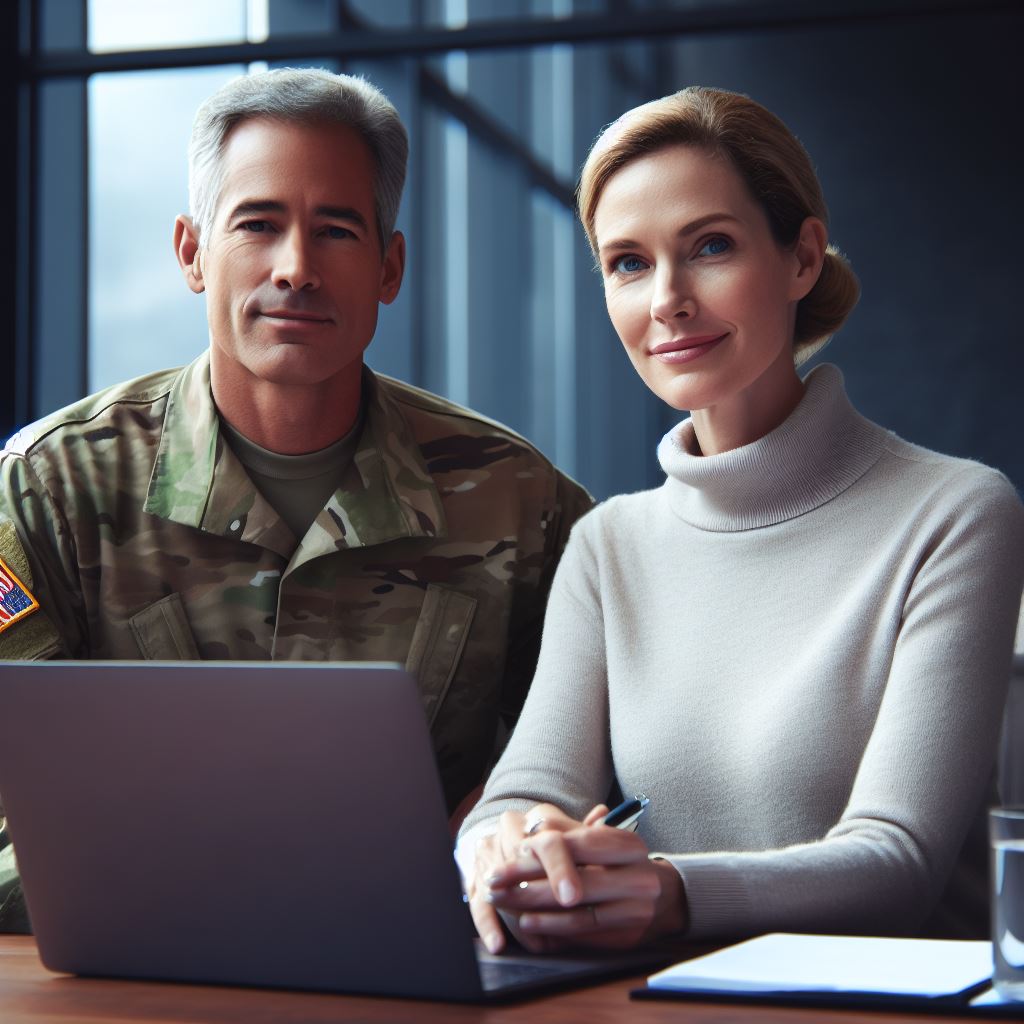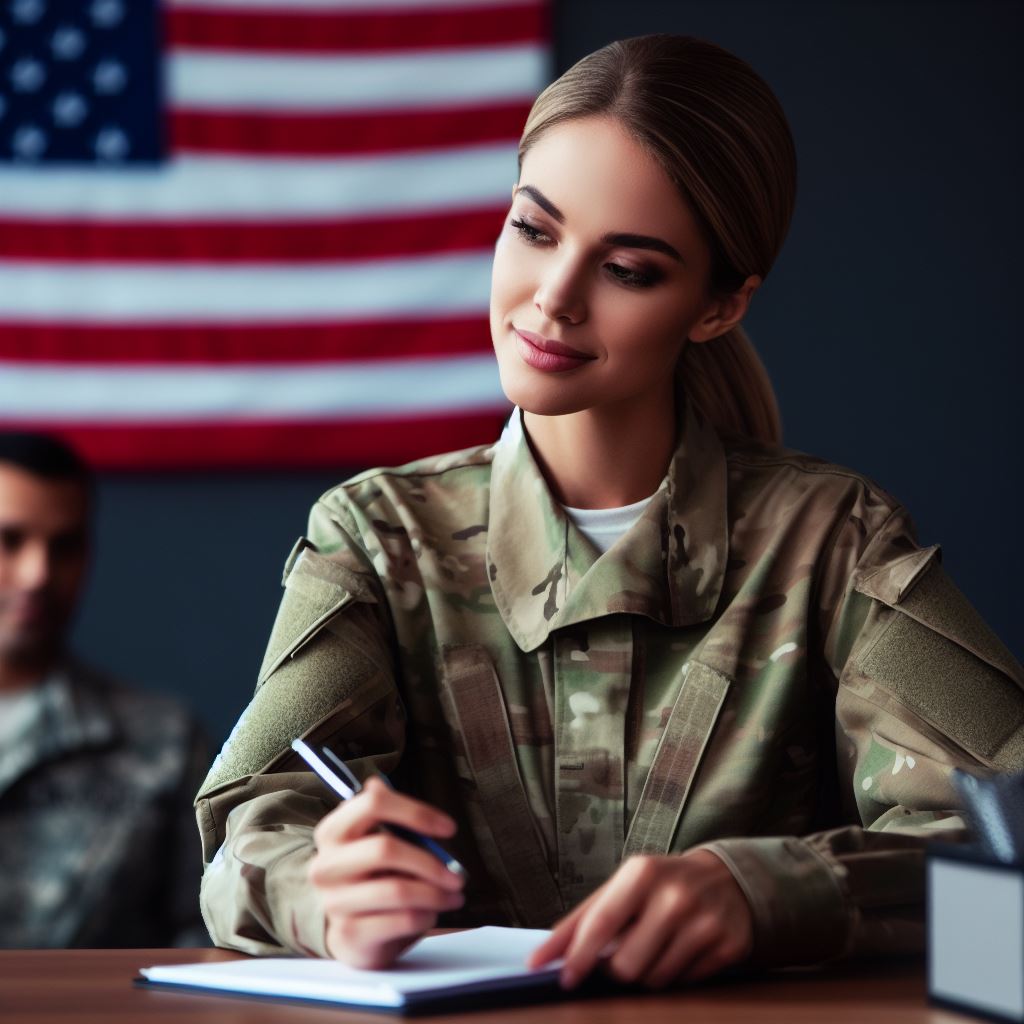Introduction
Women’s Involvement Overview
Delve into the dynamic narrative of women’s evolving roles in the U.S. military. Witness their journey marked by both progress and challenges, shaping a transformative narrative.
Breaking Barriers Importance
In the upcoming pages, we unravel the profound importance of challenging traditions.
Empowering women to break barriers in the U.S. military not only signifies progress but also stands as a testament to the resilience and dedication of those who defy norms.
The significance lies not just in numbers but in the transformative impact on the institution and the broader societal perspective.
Join us as we navigate through the stories of women who have played pivotal roles, defying stereotypes, and paving the way for a more inclusive and diverse U.S. military.
This section is a testament to their courage, highlighting the vital importance of breaking barriers for the continued progress of women in the military.
Historical background
Early participation of women in the military during the Revolutionary War
In the midst of the Revolutionary War, some women defied societal norms and joined the fight for independence.
They disguised themselves as men and served alongside their male counterparts.
Women have a long history of involvement in the United States military, often defying societal expectations and fighting for their rights.
From the early days of the Revolutionary War to the pivotal roles they played in World War I and World War II, women have made significant contributions to the defense of their nation.
The Revolutionary War marked the early participation of women in the military.
While women’s roles were limited during this time, some brave individuals defied conventions and actively fought for the cause of independence.
Disguising themselves as men, they joined the ranks and made valuable contributions to the war effort.
Women’s roles in World War I and World War II
During both World Wars, women played crucial roles in supporting the military efforts. They served as nurses, clerks, and typists, allowing more men to be deployed to the frontlines.
Fast forward to the 20th century, and women’s roles in the military expanded significantly.
During World War I and World War II, women played crucial roles in supporting military operations. They served as nurses, providing essential medical care to wounded soldiers.
They also worked as clerks and typists, handling administrative tasks and freeing up men to serve in combat positions.
Creation of the Women’s Armed Services Integration Act in 1948
Recognizing women’s invaluable contributions in World War II, the U.S. government passed the Women’s Armed Services Integration Act in 1948, ensuring permanent inclusion.
This historic act marked a pivotal moment, breaking gender barriers and reshaping military dynamics.
Since then, women have excelled in diverse military fields, challenging stereotypes in aviation, intelligence, and combat roles.
Their inclusion has enriched perspectives, fostering comprehensive understanding and contributing unique skills to problem-solving.
Despite advancements, challenges persist. Women encounter unequal treatment, sexual harassment, and limited advancement opportunities.
Ongoing efforts aim to address these issues, fostering a more inclusive and equitable military environment for women.
Throughout history, women have played integral roles, from the Revolutionary War to crucial contributions in World War I and II.
The Women’s Armed Services Integration Act solidified their permanent place, symbolizing progress in breaking barriers and traditions.
While challenges endure, strides toward equality and inclusion for women in the armed forces persist.
Challenges faced by women in the military
Resistance and discrimination from male counterparts
- Unequal treatment often experienced by women in male-dominated environments can hinder their progress.
- Hostility from male counterparts can create a challenging work environment and impede cohesion within units.
- Prejudice and derogatory attitudes towards women can lead to isolation and exclusion in certain military circles.
- Efforts to prove themselves and gain acceptance can be exhausting and distracting from their duties.
- Sexual harassment and assault are unfortunate realities for some women, further exacerbating challenges they face.
Women in the U.S. military not only face the same challenges as their male counterparts but also encounter additional obstacles unique to their gender.
Resistance and discrimination from male counterparts are persistent issues that hinder progress for women in the military.
Unequal treatment, hostility, and prejudice can create a challenging work environment and impede cohesion within units.
Women often find themselves having to work harder to prove themselves and gain acceptance, which can be exhausting and distracting from their duties.
Unfortunately, sexual harassment and assault are additional burdens that some women have to endure.
Limited opportunities for career progression
- Historically, women have faced limitations in accessing certain combat roles and career advancement opportunities.
- Gender-based assumptions have resulted in women being overlooked for promotions and leadership positions.
- Some military fields, such as special operations, continue to have restrictions on women’s participation, limiting their career options.
- Glass ceilings within the military hierarchy can hinder women’s ability to reach high-ranking positions.
- Double standards in performance evaluation can impede women’s chances of career growth.
Moreover, limited opportunities for career progression have long been a challenge for women in the military.
Historically, access to certain combat roles and advancement opportunities were limited for women.
Gender-based assumptions and double standards in performance evaluations have resulted in women being overlooked for promotions and leadership positions.
Certain military fields, like special operations, still have restrictions on women’s participation, narrowing their career options.
Additionally, glass ceilings within the military hierarchy can hinder their ability to reach high-ranking positions.
Struggles to balance family life and military service
- Military deployments and frequent relocations can disrupt family life and strain personal relationships.
- Juggling family responsibilities alongside demanding military obligations can lead to high levels of stress and guilt.
- Inadequate support systems for childcare and eldercare create additional challenges for female service members.
- Policies such as the “up or out” promotion system may pressure women to choose between family and career.
- Negative societal attitudes towards working mothers can create internal conflicts for women serving in the military.
The struggle to balance family life and military service is another significant challenge faced by women in the military.
Deployments and frequent relocations can disrupt family life and strain personal relationships.
Juggling family responsibilities alongside demanding military obligations can lead to high levels of stress and guilt.
Inadequate support systems for childcare and eldercare make it even more challenging.
Policies like the “up or out” promotion system may pressure women to choose between their family and career.
Moreover, negative societal attitudes towards working mothers can create internal conflicts for women serving in the military.
Although significant progress has been made in recent years to address these challenges and create a more inclusive environment, there is still much work to be done.
The military needs to continue implementing policies that promote gender equality and actively combat discrimination.
Providing support networks, flexible work schedules, and comprehensive family support programs can greatly assist women in balancing their military service and family responsibilities.
By recognizing and addressing these challenges, the military can maximize the potential and contributions of its female service members.
Read: Physical Fitness Standards and Tips for U.S. Security Guards
Breaking barriers
Increased opportunities for women in combat roles
- Women have been breaking barriers in the U.S. military by being allowed to serve in combat roles.
- This provides women with equal opportunities to showcase their skills and dedication in the military.
- It also allows for a more diverse and inclusive military, promoting gender equality.
In the past, the role of women in the U.S. military was limited to non-combat positions.
However, in recent years, there has been a significant shift in breaking barriers and opening doors for women to serve in combat roles.
The increased opportunities for women in combat roles have been a major step forward in gender equality within the military.
Gone are the days when women were restricted to administrative or support positions.
Now, they have the chance to showcase their skills, physical strength, and dedication in the same combat roles as their male counterparts.
Inclusion of women in previously male-dominated military branches
- Women have been making significant strides in joining previously male-dominated military branches.
- This includes branches such as the Army, Navy, Air Force, and Marines.
- The inclusion of women in these branches has shattered traditional gender stereotypes and increased diversity.
The inclusion of women in previously male-dominated military branches has also made significant progress in breaking barriers and promoting diversity.
Historically, the military has been seen as a male-dominated profession, but with the inclusion of women in branches such as the Army, Navy, Air Force, and Marines, traditional gender stereotypes are being shattered.
Recognition and celebration of women’s contributions in the military
- Women’s contributions to the U.S. military are finally being recognized and celebrated.
- Their dedication, bravery, and sacrifices are acknowledged and appreciated.
- This recognition helps empower women in the military and encourages them to continue breaking barriers.
The recognition and celebration of women’s contributions in the military are long overdue.
Women have played an instrumental role in shaping the history of the U.S. military, yet their contributions have often been overlooked.
This recognition helps empower women and encourages them to continue breaking barriers.
Transform Your Career Today
Unlock a personalized career strategy that drives real results. Get tailored advice and a roadmap designed just for you.
Start NowWomen in the military have displayed unwavering dedication, bravery, and sacrifice.
Their commitment to defending the nation and protecting its citizens deserves acknowledgment and respect.
By recognizing and celebrating their contributions, we can inspire future generations of women to pursue military careers and continue breaking barriers.
It is essential to acknowledge that breaking barriers is an ongoing process.
While significant milestones have been achieved, there is still work to be done to ensure true gender equality within the U.S. military.
Continued support, equal opportunities, and recognition are necessary to maintain progress and build a more inclusive military culture.
Concluding, the U.S. military breaks barriers by expanding women’s roles in combat, integrating them into male-dominated branches, and acknowledging their invaluable contributions.
This progress promotes gender equality, diversity, and empowers women to continue making history in the military.
It is crucial to continue striving for equal opportunities and recognition to ensure a more inclusive and diverse military for future generations.
Read: A Day in the Life of a U.S. Army Soldier: Real Stories

Success stories
Notable women who have excelled in the U.S. military
- Colonel Eileen Collins became the first woman to command a Space Shuttle mission.
- Admiral Michelle J. Howard was the first African-American woman to become a four-star admiral.
- Major General Angela Salinas became the first Hispanic woman to reach the rank of general in the Marines.
- General Ann E. Dunwoody made history as the first woman to achieve the rank of four-star general in the Army.
- Lieutenant General Susan J. Helms became the first U.S. military woman in space.
The first female generals and admirals
- In 1970, Anna Mae Hays was promoted to Brigadier General, becoming the U.S. military’s first female general.
- In 1972, Alene Duerk became the first female admiral in the U.S. Navy.
- In 1974, Jeanne M. Holm became the first female Major General in the U.S. Air Force.
- In 1978, Margaret A. Brewer became the first female Brigadier General in the U.S. Marine Corps.
- In 1993, Sheila E. Widnall became the first female Secretary of the Air Force.
Women’s accomplishments in non-combat roles
- Women serve as pilots, engineers, military police, intelligence officers, and logistics experts.
- Admiral Michelle J. Howard became the first woman to command a U.S. Navy ship.
- Colonel Nicole Malachowski flew with the U.S. Air Force Thunderbirds aerial demonstration team.
- Women have excelled in support roles, such as medical professionals, lawyers, and psychologists.
- Female service members have been recognized for their bravery and heroism in various non-combat situations.
These success stories illuminate remarkable achievements of U.S. military women.
Breaking barriers, women, from the first female generals to excelling in non-combat roles, showcase dedication and capability.
Colonel Eileen Collins, commanding a Space Shuttle mission, breaks stereotypes in space exploration.
Admiral Michelle J. Howard’s four-star success dismantles racial and gender barriers in the U.S. Navy.
Promotions like Major General Angela Salinas and General Ann E. Dunwoody underscore expanding opportunities for women in leadership.
Lieutenant General Susan J. Helms pioneers women’s roles in the space program, proving limitless capabilities.
Beyond groundbreaking officers, women excel as pilots, engineers, military police, intelligence officers, and logistics experts, showcasing diverse competencies.
Admiral Michelle J. Howard’s naval leadership highlights women’s prowess in traditionally male roles.
Colonel Nicole Malachowski’s role with the U.S. Air Force Thunderbirds demonstrates women’s excellence in high-pressure positions.
In support roles like medical professionals, lawyers, and psychologists, women significantly contribute to military success.
These stories underscore the importance of recognizing and celebrating women’s accomplishments, inspiring future generations and emphasizing gender as no barrier to armed forces success.
Read: Balancing Vigilance and Courtesy: A U.S. Security Guard Challenge
Explore Further: Cybersecurity & the Military: Protecting the Digital Realm
The impact of women in the U.S. military
Enhancement of diversity and representation in the military
- Women’s presence in the U.S. military has significantly increased diversity and representation.
- This has allowed for a more inclusive and equitable military culture where all individuals are valued.
- The inclusion of women brings different perspectives and experiences, enriching the overall effectiveness of the military.
Women in the U.S. military have had a profound impact on various aspects, from enhancing diversity and representation to contributing to national security and inspiring future generations.
The presence of women in the military has greatly enhanced diversity and representation within its ranks.
Women bring unique perspectives, experiences, and skills, fostering a more inclusive and equitable military culture.
They add value by showcasing the strength of diversity and ensuring that all individuals are respected and valued for their contributions.
BContribution to national security and defense
- Women have made significant contributions to national security and defense throughout history.
- They have served in various roles, from combat positions to intelligence and strategic planning.
- Their skills, expertise, and dedication have been vital in protecting and defending the nation.
Moreover, women have made significant contributions to national security and defense. Gone are the days when women’s roles were restricted to support positions.
They now serve in combat roles, intelligence, and strategic planning, among others. Women have proven their capabilities and dedication, displaying unwavering commitment in protecting the nation.
Inspiring future generations of women to pursue military careers
- Women in the U.S. military serve as role models, inspiring young girls to consider military careers.
- Their achievements and bravery encourage girls to break barriers and challenge societal norms.
- By seeing women in leadership positions, young girls realize that they can achieve anything they set their minds to.
The impact of women in the U.S. military extends beyond their current service.
They serve as role models, inspiring future generations of women to pursue military careers.
Young girls see women breaking barriers and defying stereotypes, encouraging them to believe in their own abilities and aspirations.
Women in leadership positions provide tangible proof that gender is not a limitation and that they can excel in any field they choose.
By breaking barriers and traditions, women in the U.S. military set an example for all. Their determination, resilience, and bravery pave the way for a more inclusive and equal future.
They inspire young girls to dream big and pursue careers that were once considered out of reach.
These women demonstrate that dedication, hard work, and talent are what truly matter, regardless of gender.
In closing, the impact of women in the U. S. military is significant and far-reaching.
Their presence enhances diversity and representation, contributes to national security, and inspires future generations.
Women in the military have shattered stereotypes, opening doors for all individuals to serve their country with honor and pride.
Their contributions should be recognized and celebrated as they continue to break barriers and forge new paths within the military.
Read: Veterans Transitioning to Security Roles: A Guide for the U.S. Market
Delve into the Subject: Challenges and Rewards: Life as a Detective in the USA
Discover More: Pay, Benefits, & Retirement: The Financial Side of Policing
Transform Your Career Today
Unlock a personalized career strategy that drives real results. Get tailored advice and a roadmap designed just for you.
Start NowConclusion
Women’s Journey Recap
Embark on a transformative journey as women in the U.S. military shatter barriers and redefine traditions, marking unprecedented progress.
Continued Support Importance
Acknowledging and amplifying the significance of women’s achievements remain crucial for fostering an inclusive and diverse military landscape.
Hope for Equality
Looking ahead, envision a future where the U.S. military thrives on equality, providing more opportunities for women to excel and lead.
In this concluding section, reflect on the resilience and dedication exhibited by women who’ve contributed significantly.
Their journey is not just a testament to individual accomplishments but a collective stride toward gender equality in the armed forces.
As society evolves, continued support and recognition become indispensable.
The significance of women’s roles in the military extends beyond individual achievements—it shapes the narrative of a more inclusive future.
Let this section serve as a call to action, urging for sustained efforts, support systems, and policies that promote equality in the U.S. military.
[E-Books for Sale]
The Big Book of 500 High-Paying Jobs in America: Unlock Your Earning Potential
$19.99 • 500 High-Paying Jobs • 330 pages
Explore 500 high-paying jobs in America and learn how to boost your career, earn more, and achieve success!
See All 500 High-Paying Jobs of this E-Book
1001 Professions Without a Degree: High-Paying American Jobs You Can Start Now
$19.99 • 1001 Professions Without a Degree • 174 pages
Discover 1001 high-paying jobs without a degree! Unlock career tips, skills, and success strategies for just $19.99!




